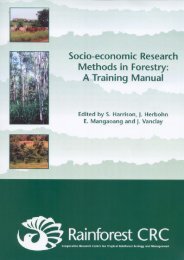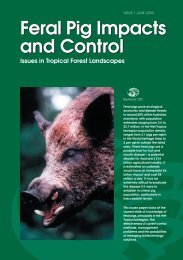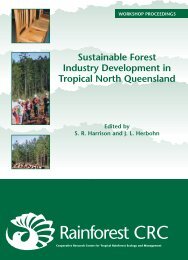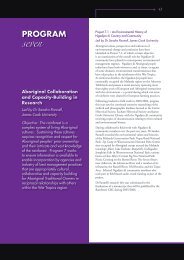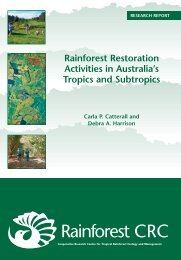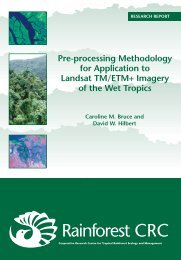Reconciling Nature and Culture in a Global Context? - Rainforest ...
Reconciling Nature and Culture in a Global Context? - Rainforest ...
Reconciling Nature and Culture in a Global Context? - Rainforest ...
Create successful ePaper yourself
Turn your PDF publications into a flip-book with our unique Google optimized e-Paper software.
<strong>Reconcil<strong>in</strong>g</strong> <strong>Nature</strong> <strong>and</strong> <strong>Culture</strong> <strong>in</strong> a <strong>Global</strong> <strong>Context</strong>?Lessons from the World Heritage ListSuomenl<strong>in</strong>na (<strong>in</strong> the F<strong>in</strong>nish language, ‘Fort of F<strong>in</strong>l<strong>and</strong>’), <strong>and</strong> was briefly used as a prisoncamp to hold some of the 80,000 prisoners of war result<strong>in</strong>g from the civil war of 1918 (TheEstate of Olof af Hällstrom 2004: 49). In the period 1919-1973, Suomenl<strong>in</strong>na was a F<strong>in</strong>nishgarrison town.The year 1973 marked the end of a 225-year long military epoch as adm<strong>in</strong>istration of thefortress was h<strong>and</strong>ed over to the civil Govern<strong>in</strong>g Body of Suomenl<strong>in</strong>na. This body has beenresponsible for the restoration work <strong>and</strong> developments at the fortress site to the present date.Today, Suomenl<strong>in</strong>na is identified as “a monument, a cultural centre, a borough <strong>and</strong> a touristattraction” (The Estate of Olof af Hällstrom 2004: 49). As a borough, Suomenl<strong>in</strong>na is theyear-round home to a population of approximately 850 people <strong>and</strong> conta<strong>in</strong>s a “k<strong>in</strong>dergarten,primary school, shop <strong>and</strong> library” (The Estate of Olof af Hällstrom 2004: 50). The fortresscomplex also operates as a ‘labour colony’ with 80 or so <strong>in</strong>mates, who carry out most of therestoration work at the site (The Estate of Olof af Hällstrom 2004: 50). The military traditionof Suomenl<strong>in</strong>na, however, still cont<strong>in</strong>ues at the site as part of the fortress houses the F<strong>in</strong>nishNaval Academy.As this brief account illustrates, the history of the fortress is <strong>in</strong>extricably tied to the history ofEurope <strong>and</strong> the geo-political battles for power between Sweden <strong>and</strong> Russia, <strong>and</strong> laterbetween Russia, France <strong>and</strong> Great Brita<strong>in</strong>. In this respect, the region that became F<strong>in</strong>l<strong>and</strong> <strong>in</strong>1917 is presented as the geo-political borderl<strong>and</strong>s <strong>and</strong> expendable stage upon which thesebattles for European supremacy were sometimes fought. This history of military dom<strong>in</strong>ation<strong>and</strong> defeat <strong>in</strong>volv<strong>in</strong>g Europe’s super-powers of the day is also presented at the sea-fortressof Suomenl<strong>in</strong>na as ‘F<strong>in</strong>l<strong>and</strong>’s history’. This said, little <strong>in</strong>formation is provided about the roleof local people <strong>in</strong> this history of colonisation <strong>and</strong> counter-occupation. Indeed, given theemphasis upon the military achievements of Sweden <strong>and</strong> Russia, the fortress can be readily<strong>in</strong>terpreted by visitors as a monument to F<strong>in</strong>nish oppression <strong>and</strong> their marg<strong>in</strong>al role <strong>in</strong> theregion’s political history.As a monument to F<strong>in</strong>l<strong>and</strong>’s history, the fortress is also made to st<strong>and</strong> as a visual marker ofthe beg<strong>in</strong>n<strong>in</strong>g of this history. There is no <strong>in</strong>formation presented at the visitor centre about theidentity of those people occupy<strong>in</strong>g the area prior to Swedish control some 600 years prior tothe establishment of the fortress, or any sense that a local history existed prior to theconstruction itself. While more than 2,000 men were <strong>in</strong>volved <strong>in</strong> the orig<strong>in</strong>al build<strong>in</strong>g of thefortress, mak<strong>in</strong>g it the “biggest construction project ever undertaken by the Swedish realm”(The Estate of Olof af Hällstrom 2004: 36), their identities are not revealed <strong>in</strong> the displays atthe visitor centre. With its emphasis upon the technicalities <strong>and</strong> pr<strong>in</strong>ciples of fortification ofthe day, <strong>and</strong> its presentation of history as the story of k<strong>in</strong>gs <strong>and</strong> queens <strong>and</strong> their variouspolitical mach<strong>in</strong>ations on the chessboard of Europe, the World Heritage site glorifies one ofthe more monumental expressions of the ‘colonial experience’. In do<strong>in</strong>g so, the WorldHeritage site conceals some of more shameful episodes associated with the expansion ofempires <strong>and</strong> k<strong>in</strong>gdom build<strong>in</strong>g.As the historian Simon Schama rem<strong>in</strong>ds us, not all l<strong>and</strong>scapes are “places of delight”, norare all memories “pastoral picnics” (1995: 18). Yet, notwithst<strong>and</strong><strong>in</strong>g the brutal nature ofSuomenl<strong>in</strong>na history, little of the horror <strong>and</strong> suffer<strong>in</strong>g that Schama alludes to is depicted <strong>in</strong>this sanitised vision of F<strong>in</strong>l<strong>and</strong>’s past. Indeed, there is little suggestion that the historicaloccupation of F<strong>in</strong>l<strong>and</strong> by Sweden <strong>and</strong> Russia is a colonis<strong>in</strong>g act. In this sense,Suomenl<strong>in</strong>na, as a World Heritage cultural property, is not alone. The World Heritage List isreplete with properties that celebrate <strong>and</strong> protect colonial monuments, but not necessarily thepa<strong>in</strong>ed memories associated with the production of these architectural glories. As Fowlerpo<strong>in</strong>ts out (2003: 53), while the World Heritage List acknowledges the <strong>in</strong>cidence of globalwarfare <strong>in</strong> the form of fortifications, urban defences <strong>and</strong> naval ports, it has yet to recognise‘war l<strong>and</strong>scapes’. And, I would add, truly depict the other, less picturesque, legacies of acolonial heritage.49




